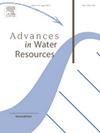stamnet -一个时空注意模块和网络,用于提升隐隐区反应性输运模拟
IF 4.2
2区 环境科学与生态学
Q1 WATER RESOURCES
引用次数: 0
摘要
反应输运(RT)模拟是理解和预测地下现象的重要工具。然而,RT是计算密集型的,复杂的模拟可能在数值上不稳定。在这里,我们提出了STAMNet,一个基于低参数注意力的神经网络套件,可以提高和提高样本反应性传输模拟,应用于下潜区生物修复的示例问题。我们表明,一个简单的MLP比标准多物理场RT模拟提供了30倍的加速,并且可以通过使用1 × 2 m模拟的输出作为输入,准确地(≈90% R2)预测1 × 20 m RT模拟的多个变量的输出。我们在优化的MLP中加入了有效的信道关注,这显著提高了平均误差,但不影响R2。我们进一步开发了一种新的时空注意模块(STAM),结果均方误差和R2都得到了改善(92.5%)。最后,我们提出了一种利用STAM在二维空间中精确(99.9% R2)上样模拟的网络架构。具体来说,我们的模型允许在x和y维度上进行2倍的模拟上采样,以将粗粒度的输入转换为细粒度的输出。这些模型在蒙特卡罗式的生物修复研究中具有潜在的用途,所提出的工作可以作为对大量时空输出进行准确预测的概念验证。本文章由计算机程序翻译,如有差异,请以英文原文为准。
STAMNet—A spatiotemporal attention module and network for upscaling reactive transport simulations of the hyporheic zone
Reactive transport (RT) simulations are important tools for understanding and predicting phenomena in the subsurface. However, RT is computationally intensive and complex simulations can be numerically unstable. Here, we present STAMNet, a low-parameter attention-based suite of neural nets that can upscale and upsample reactive transport simulations, applied to example problem of bioremediation in the hyporheic zone. We show that a simple MLP offers 30x speedup over standard multiphysics RT simulations and can accurately ( ) predict the output of multiple variables of a 1x20 meter RT simulation by using the output from a 1 × 2 m simulation as input. We add efficient channel attention to our optimized MLP which significantly improves the mean average error but does not affect the . We further develop a novel spatiotemporal attention module (STAM), which results in improvements both in mean square error and (92.5%). Finally, we present a network architecture that utilizes STAM to accurately (99.9% ) upsample simulations in two dimensions. Specifically, our model allows for the 2x upsampling of simulations in the and dimensions to convert a coarse-grained input into a fine-grained output. These models have potential use for Monte-Carlo-style investigations of bioremediation and the work presented serves as a proof-of-concept for accurate prediction of large sets of spatiotemporal outputs.
求助全文
通过发布文献求助,成功后即可免费获取论文全文。
去求助
来源期刊

Advances in Water Resources
环境科学-水资源
CiteScore
9.40
自引率
6.40%
发文量
171
审稿时长
36 days
期刊介绍:
Advances in Water Resources provides a forum for the presentation of fundamental scientific advances in the understanding of water resources systems. The scope of Advances in Water Resources includes any combination of theoretical, computational, and experimental approaches used to advance fundamental understanding of surface or subsurface water resources systems or the interaction of these systems with the atmosphere, geosphere, biosphere, and human societies. Manuscripts involving case studies that do not attempt to reach broader conclusions, research on engineering design, applied hydraulics, or water quality and treatment, as well as applications of existing knowledge that do not advance fundamental understanding of hydrological processes, are not appropriate for Advances in Water Resources.
Examples of appropriate topical areas that will be considered include the following:
• Surface and subsurface hydrology
• Hydrometeorology
• Environmental fluid dynamics
• Ecohydrology and ecohydrodynamics
• Multiphase transport phenomena in porous media
• Fluid flow and species transport and reaction processes
 求助内容:
求助内容: 应助结果提醒方式:
应助结果提醒方式:


